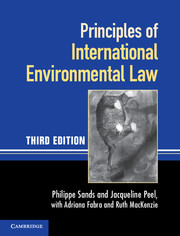Book contents
- Frontmatter
- Contents
- Foreword
- Preface and acknowledgments to the first edition
- Preface and acknowledgments to the second edition
- Preface and acknowledgments to the third edition
- Table of cases
- Table of treaties and other international instruments
- Abbreviations
- Part I The legal and institutional framework
- Part II Principles and rules establishing standards
- 6 General principles and rules
- 7 Atmospheric protection and climate change
- 8 Freshwater resources
- 9 Oceans, seas and marine living resources
- 10 Biological diversity
- 11 Hazardous substances and activities
- 12 Waste
- 13 The polar regions: Antarctica and the Arctic
- Part III Techniques for implementing international principles and rules
- Part IV Linkage of international environmental law and other areas of international law
- Index
- References
7 - Atmospheric protection and climate change
from Part II - Principles and rules establishing standards
Published online by Cambridge University Press: 05 June 2012
- Frontmatter
- Contents
- Foreword
- Preface and acknowledgments to the first edition
- Preface and acknowledgments to the second edition
- Preface and acknowledgments to the third edition
- Table of cases
- Table of treaties and other international instruments
- Abbreviations
- Part I The legal and institutional framework
- Part II Principles and rules establishing standards
- 6 General principles and rules
- 7 Atmospheric protection and climate change
- 8 Freshwater resources
- 9 Oceans, seas and marine living resources
- 10 Biological diversity
- 11 Hazardous substances and activities
- 12 Waste
- 13 The polar regions: Antarctica and the Arctic
- Part III Techniques for implementing international principles and rules
- Part IV Linkage of international environmental law and other areas of international law
- Index
- References
Summary
INTRODUCTION
The protection of the atmosphere was a relative latecomer to international environmental regulation but is now well established. With limited exceptions, until 1979 no treaty sought, as its primary purpose, to place limits on the right of states to allow atmospheric emissions that caused environmental damage. Some treaties had, however, called for general preventive strategies. Since 1979, numerous treaties and other international acts have addressed the protection of the atmosphere. Although there is no atmospheric equivalent to the 1982 UN Convention on the Law of the Sea, international legal instruments have been adopted at the regional and global level which address a range of issues, including: transboundary pollution by sulphur dioxide, nitrogen oxide, volatile organic compounds, heavy metals and persistent organic pollutants (POPs); the protection of the ozone layer; the prevention of climate change; and the protection of the environment of outer space. The precedents set by treaties relating to the protection of other environmental media, in particular the marine environment, have contributed to the development of these rules.
Landmarks in the development of international law in this area include: the 1938 and 1941 decisions in the Trail Smelter case; the applications brought to the ICJ by Australia and New Zealand against France with respect to French atmospheric nuclear tests in the Pacific Ocean region; growing evidence in Europe and North America in the 1970s of acid rain damage from atmospheric emissions of sulphur compounds; the 1986 Chernobyl accident; growing evidence in the 1980s of depletion of the ozone layer; greater awareness of the threats posed by forest fires with transnational effects, such as those in Indonesia in 1997 which caused widespread regional problems, and, mostly recently, consolidation of scientific evidence that increased atmospheric concentrations of carbon dioxide and other greenhouse gases are likely to cause temperatures to increase worldwide with consequential adverse effects.
- Type
- Chapter
- Information
- Principles of International Environmental Law , pp. 238 - 302Publisher: Cambridge University PressPrint publication year: 2012



